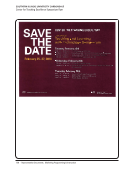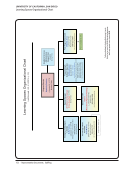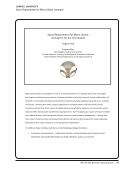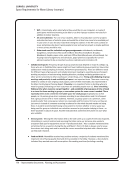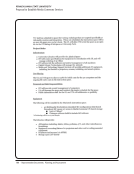SPEC Kit 342: Next-Gen Learning Spaces · 75
One of our engineering librarians used the flexibility of our problem-based technology classroom to work with a couple
of the mechanical engineering design teams at the same time. She was able to move easily between teams, share
common problems/solutions as they arose, and make better use of her and the students’ time.
Our chemistry librarian partnered with the Chemistry department to conduct three introductory, chemistry-focused
information literacy sessions for freshman chemistry majors, which featured an information/library scavenger hunt that
started and finished in the learning space classroom. Session began in the classroom, moved to the desktop computers
in the open group collaborative area for searching task, to the compact shelving for print reference book, to other floors
in the library, then back to the classroom. Librarian and circulation staff participated. Students appeared engaged and
course instructor indicated satisfaction and continued the partnership.
Printmaking in the Library East Commons had Multimedia Instruction Librarian, School of Literature, Media, &
Communication instructors, and local arts center as partners. Materials included Adobe Illustrator instruction, ink,
printmaking blocks, paper, carving tools, etc. Success was measured by reflective statements from students at the end.
Prompted grant proposal for future similar endeavors.
Recently, we used our new collaborative classroom to host an open house for newly admitted prospective students
in partnership with our world languages departments. We set aside two hours for the event. The six tables in the
classroom were allocated to different language groups who used the technology in the room to share details about their
part of the world. The Japanese table showed an animated film and displayed objects that students could touch and
play with. Another table displayed a world map where students could annotate directly on the writable glass to indicate
where they were from or had visited. The room sound system was used to share an international music medley. Simple
drawing and mark-up activities were available around the room. On the glass porch just outside the classroom, faculty
and students wrote “Welcome” in dozens of different languages and drew funny pictures of themselves. Students could
connect their phones and tablets to the different projectors around the classroom. The space lent itself well to casual
interaction, humor, and a food-friendly and iPad/tablet-friendly afternoon.
Sci Pop talks: measured attendance, used social media, projection, microphone
SPSS instruction, led by students hired as part of the Research Commons
Student use of GIS is supported by the library. GIS prizes are awarded to the best graduate and undergraduate projects
that utilize the GIS services of the library. Posters are displayed in the library for about a week.
Students are asked to compile a preliminary bibliography on a paper topic prior to meeting with a librarian in one of our
research consultation spaces. During the meeting they discuss the methods they used to compile the bibliography, and
they are introduced to additional resources and methods that might be helpful. The final bibliography used in their paper
assignment is then compared with their preliminary bibliography.
The first undergraduate research fair accepted applications from years 1 to 4 providing 37 poster sessions in the
Collaboratory where attendees, including proud parents and friends, applauded the recipients of eight awards and
honourable mentions. The Undergraduate Research Fair is producing an online journal that is also tied to the curriculum
for a 4th year publishing class. The winners and planners of the Undergraduate Research Fair were invited to the
University Research Gala event afterward where winners from the fair were celebrated. It was an outstanding success
as evidenced by the fact that nearly 100 applications were received and over 300 people attended, also by the fact that
the event was recognized as promoting the university research culture at the university-wide research gala and that an
increasing level of monetary support is being received through donations from campus partners and donors.
The library creates instruction for many of the first year writing programs. One, Making of The Modern World, has
numerous sections and classes. We create online guides, in-person instruction, and online tutorials to work with 800 of
these students in a semester. The instruction is provided by librarians and staff in order to teach approximately 8 to 10
One of our engineering librarians used the flexibility of our problem-based technology classroom to work with a couple
of the mechanical engineering design teams at the same time. She was able to move easily between teams, share
common problems/solutions as they arose, and make better use of her and the students’ time.
Our chemistry librarian partnered with the Chemistry department to conduct three introductory, chemistry-focused
information literacy sessions for freshman chemistry majors, which featured an information/library scavenger hunt that
started and finished in the learning space classroom. Session began in the classroom, moved to the desktop computers
in the open group collaborative area for searching task, to the compact shelving for print reference book, to other floors
in the library, then back to the classroom. Librarian and circulation staff participated. Students appeared engaged and
course instructor indicated satisfaction and continued the partnership.
Printmaking in the Library East Commons had Multimedia Instruction Librarian, School of Literature, Media, &
Communication instructors, and local arts center as partners. Materials included Adobe Illustrator instruction, ink,
printmaking blocks, paper, carving tools, etc. Success was measured by reflective statements from students at the end.
Prompted grant proposal for future similar endeavors.
Recently, we used our new collaborative classroom to host an open house for newly admitted prospective students
in partnership with our world languages departments. We set aside two hours for the event. The six tables in the
classroom were allocated to different language groups who used the technology in the room to share details about their
part of the world. The Japanese table showed an animated film and displayed objects that students could touch and
play with. Another table displayed a world map where students could annotate directly on the writable glass to indicate
where they were from or had visited. The room sound system was used to share an international music medley. Simple
drawing and mark-up activities were available around the room. On the glass porch just outside the classroom, faculty
and students wrote “Welcome” in dozens of different languages and drew funny pictures of themselves. Students could
connect their phones and tablets to the different projectors around the classroom. The space lent itself well to casual
interaction, humor, and a food-friendly and iPad/tablet-friendly afternoon.
Sci Pop talks: measured attendance, used social media, projection, microphone
SPSS instruction, led by students hired as part of the Research Commons
Student use of GIS is supported by the library. GIS prizes are awarded to the best graduate and undergraduate projects
that utilize the GIS services of the library. Posters are displayed in the library for about a week.
Students are asked to compile a preliminary bibliography on a paper topic prior to meeting with a librarian in one of our
research consultation spaces. During the meeting they discuss the methods they used to compile the bibliography, and
they are introduced to additional resources and methods that might be helpful. The final bibliography used in their paper
assignment is then compared with their preliminary bibliography.
The first undergraduate research fair accepted applications from years 1 to 4 providing 37 poster sessions in the
Collaboratory where attendees, including proud parents and friends, applauded the recipients of eight awards and
honourable mentions. The Undergraduate Research Fair is producing an online journal that is also tied to the curriculum
for a 4th year publishing class. The winners and planners of the Undergraduate Research Fair were invited to the
University Research Gala event afterward where winners from the fair were celebrated. It was an outstanding success
as evidenced by the fact that nearly 100 applications were received and over 300 people attended, also by the fact that
the event was recognized as promoting the university research culture at the university-wide research gala and that an
increasing level of monetary support is being received through donations from campus partners and donors.
The library creates instruction for many of the first year writing programs. One, Making of The Modern World, has
numerous sections and classes. We create online guides, in-person instruction, and online tutorials to work with 800 of
these students in a semester. The instruction is provided by librarians and staff in order to teach approximately 8 to 10










































































































































